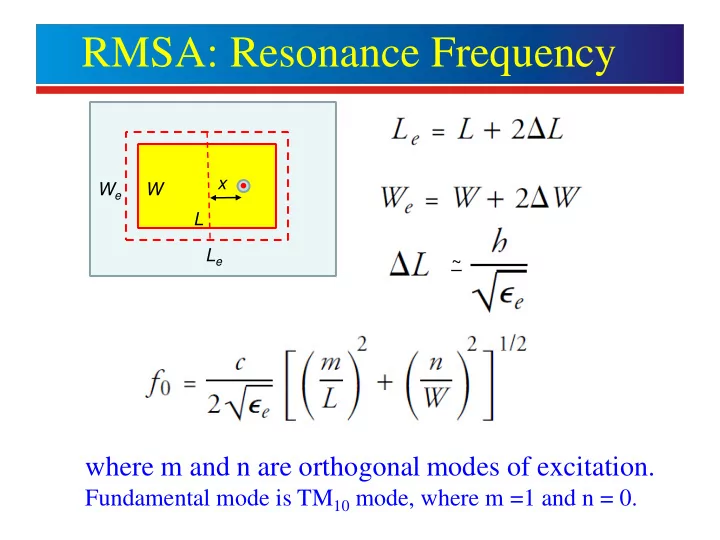

RMSA: Resonance Frequency x W e W L L e ~ where m and n are orthogonal modes of excitation. Fundamental mode is TM 10 mode, where m =1 and n = 0.
RMSA – Characterization
RMSA: Design Equations Smaller or larger W can be taken than the W obtained from this expression. BW α W and Gain α W Choose feed-point x between L /6 to L /4.
RMSA: Design Example Design a RMSA for Wi-Fi application (2.400 to 2.483 GHz) Chose Substrate: ε r = 2.32, h = 0.16 cm and tan δ = 0.001 = 3 x 10 10 / ( 2 x 2.4415 x 10 9 x √1.66) = 4.77 cm. W = 4.7 cm is taken = 2.23 = 3 x 10 10 / ( 2 x 2.4415 x 10 9 x √2.23) cm L e = 4.11 cm L = L e – 2 ∆L = 4.11 – 2 x 0.16 / √2.23 = 3.9 cm
RMSA: Design Example – Simulation using IE3D L = 3.9 cm, W = 4.7 cm, x = 0.7 cm ε r = 2.32, h = 0.16 cm and tan δ = 0.001 BW for |S11| < -10 dB is from Z in = 54 Ω at f = 2.414 GHz 2.395 to 2.435 GHz = 40 MHz Designed f = 2.4415 and Simulated f = 2.414 GHz % error = 1.1%. Also, BW is small. SOLUTION: Increase h and reduce L
Effect of Various Parameters on Performance of RMSA W e W x L L e L = 3 cm and W = 4 cm Substrate parameters: ε r = 2.55, h = 0.159 cm, and tan δ = 0.001 P robe diameter = 0.12 cm for SMA connector. RMSA is analyzed using commercially available IE3D software.
Effect of Feed Point Location ( x ) For Infinite Ground Plane With increase in x , input impedance plot shifts right towards higher impedance values.
Rectangular Microstrip Antenna (RMSA) Y Top X W View x L Side r h View Ground plane Co-axial feed
Effect of Width ( W ) With increase in W , aperture area, ε e and fringing fields increase, hence frequency decreases and input impedance plot shifts towards lower impedance values. BW α W and Gain α W
Effect of Thickness ( h ) BW α h/ λ 0 As h increases, fringing fields and probe inductance increase, frequency decreases and input impedance plot shifts upward. to reduce surface waves However,
Effect of Probe Diameter As probe diameter decreases, its inductance increases, so resonance frequency decreases and input impedance locus moves upward to the inductive region.
Effect of Loss Tangent (tan δ ) With increase in tan δ , dielectric losses increase, so input impedance locus moves left towards lower impedance value. BW increases but efficiency and gain decrease.
Effect of Dielectric Constant ( ε r ) With decrease in ε r , both L and W increase, which increases fringing fields and aperture area, hence both BW and Gain increase.
RMSA – Pattern for Different ε r (TM 10 mode) With increase in ε r , size of the antenna decreases for same resonance frequency. Hence, gain decreases and HPBW increases.
RMSA – Pattern for Different ε r (TM 30 mode) For TM 30 mode, L e = 3 λ 0 / (2 √ ε e ) For ε r = 2.32, L e ~ λ 0 So, two radiating slots will be at a distance of λ 0 yielding grating lobe in E-plane.
RMSA – Dual Polarization (TM 10 and TM 01 modes) ( - - - ) theoretical, ( —— ) measured L = 10.1 cm and W = 7.9 cm Measured resonance frequencies Orthogonal Feeds at: are 712 MHz and 913 MHz for x = 3.8 cm and y = 2.9 cm two orthogonal modes Substrate Parameters: ε r = 4.3, h = 0.16 cm, tan δ = 0.02
Effect of Finite Ground Plane Finite Ground Plane Size is taken as L g = L + 6h + 6h and W g = W + 6h + 6h
MSA – BW Variation with h and f
Square MSA in Air – VSWR Plot Square MSA on a finite ground plane. Low cost - Metallic plate suspended in air and fed by a co-axial feed. BW for VSWR < 2 is 95 MHz at 1.8 GHz (% BW ~ 5%)
Square MSA in Air – Radiation Pattern Radiation Pattern at 1.8 GHz F/B = 15 dB Cross Polar < 20 dB
MSA – Suspended Configurations
CMSA: Resonance Frequency For Fundamental TM 11 Mode: f 0 ~ 8.791 / [(a + h/ √ε r ) √ε e ] GHz where a and h are in cm and ε e < ε r where K nm is the mth root Design Equation: of the derivative of the a ~ 8.791 / (f 0 √ε e ) - h /√ε r Bessel function of order n Choose feed-point x between 0.3 a to 0.5 a
Recommend
More recommend